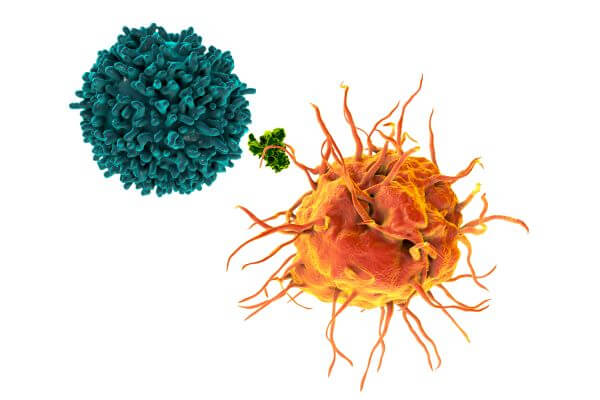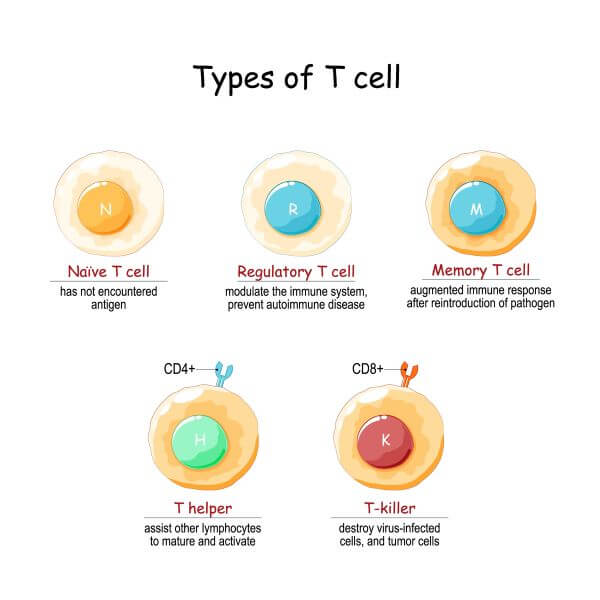Langerhans cells are a type of immune cell found primarily in the epidermis that have important roles in the stimulation and suppression of the adaptive immune response. They are members of the dendritic cell family and function as antigen-presenting cells. When a Langerhans cell encounters a pathogen, it engulfs the infectious agent and breaks it down into protein fragments. Some of these fragments are displayed on the surface of the cell and presented to naïve T cells in the lymph nodes to stimulate an immune response.

What is a Langerhans Cell?
Langerhans cells are a type of immune cell found in the skin (AKA the epidermis). Like all immune cells, Langerhans cells are formed in the bone marrow. Once released from the bone marrow, they circulate in the blood before migrating to the skin, where they guard the epidermis against infection from pathogens.
Langerhans cells are members of the dendritic cell family and function as antigen-presenting cells (APCs) in the skin. They capture any pathogens they find roaming the epidermis and display their antigens on their surface to stimulate other immune cells into action.
Where Are Langerhans Cells Found?
Langerhans cells are present in all layers of the epidermis and the respiratory, digestive, and urogenital tracts. When they encounter a pathogen, Langerhans cells migrate to the lymph nodes to present their antigens to naïve T cells and activate the adaptive immune response.

Function of Langerhans Cells
Langerhans cells are members of the dendritic cell family. Their main role is to alert other components of the adaptive immune system to the presence of pathogens and other infectious agents on the skin.
Langerhans Cells as Antigen-Presenting Cells (APCs)
Langerhans cells are phagocytic cells, meaning they engulf other cells or particles. They are also antigen-presenting cells (APCs), and can display fragments of engulfed pathogens on their cell surface to stimulate an adaptive immune response.
When a Langerhans cell encounters a harmful pathogen in the skin, it ingests it and breaks it down into protein fragments. Some of these fragments are displayed on the surface of the Langerhans cells as part of the Major Histocompatibility Complex (MHC).
Next, the Langerhans cells migrate to the lymph nodes to present their antigens to naïve T cells. This activates the T cells to launch an immune response and stimulates them to find and destroy the invading pathogen.

Immune Suppression by Langerhans Cells
Langerhans cells play a role in stimulating the adaptive immune response against pathogens, but they are also known to suppress immune function. The skin is naturally populated by ‘friendly’ bacteria which, although ‘foreign’ to the body, are not known to cause disease. In the presence of non-pathogenic bacteria, the Langerhans cells coordinate immune tolerance, i.e., they prevent the immune system from responding. This prevents unnecessary and potentially harmful activation of the immune system.
Langerhans Cells Prevent Autoimmunity
Langerhans cells help to prevent autoimmunity (an immune response against healthy cells) by promoting immune tolerance.
Under ‘non-dangerous’ conditions (i.e., when there are no pathogenic agents present), Langerhans cells promote the activation and proliferation of T regulatory (Treg) cells in the skin. Treg cells secrete cytokines that promote immune tolerance and, in doing so, prevent unnecessary and potentially harmful immune activation.
In the presence of a pathogen, however, Langerhans cells promote the activation of effector T cells and limit the activation of Treg cells. They stimulate the effector cells (namely, helper and cytotoxic T cells) to launch an immune response against the foreign invader and clear infections from the skin.

What is Langerhans Cell Histiocytosis (LCH)?
Langerhans Cell Histiocytosis (LHC) is a rare type of cancer in which abnormal Langerhans cells grow and multiply rapidly. This leads to a build-up of Langerhans cells in various regions of the body, including the skin, mouth, lymph nodes, thymus, eyes, endocrine system, central nervous system (CNS), liver, spleen, lungs, or bone marrow. The abnormal proliferation of Langerhans cells can cause tissue damage and lesions to form in affected body parts, and symptoms vary depending on which region of the body is affected.
In approximately 80% of cases, LCH affects the bones (typically the skull or the bones of the arms or legs). This causes pain and swelling and may lead to bone fracture. LHC is also known to frequently affect the skin, where it may cause rashes, bumps, and blisters that can be mild or severe. If the pituitary gland is affected, LHC may disrupt hormone production, which may lead to infertility or, in adolescents and children, delayed or absent puberty. LHC may also affect the thyroid, leading to the disruption of the patient’s normal skin and hair texture, body temperature, and behavior.
